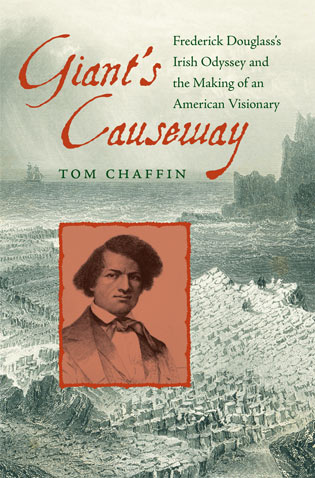In 1845, seven years after fleeing bondage in Maryland, Frederick Douglass was in his late twenties and already a celebrated lecturer across the northern United States. The recent publication of his groundbreaking Narrative of the Life of Frederick Douglass, an American Slave had incited threats to his life, however, and to place himself out of harm’s way he embarked on a lecture tour of the British Isles, a journey that would span seventeen months and change him as a man and a leader in the struggle for equality.
In the first major narrative account of a transformational episode in the life of this extraordinary American, Tom Chaffin chronicles Douglass’s 1845-47 lecture tour of Ireland, Scotland, and England. It was, however, the Emerald Isle, above all, that affected Douglass–from its wild landscape (“I have travelled almost from the hill of ‘Howth’ to the Giant’s Causeway”) to the plight of its people, with which he found parallels to that of African Americans. Writing in the San Francisco Chronicle, critic David Kipen has called Chaffin a “thorough and uncommonly graceful historian.” Possessed of an epic, transatlantic scope, Chaffin’s new book makes Douglass’s historic journey vivid for the modern reader and reveals how the former slave’s growing awareness of intersections between Irish, American, and African history shaped the rest of his life.
The experience accelerated Douglass’s transformation from a teller of his own life story into a commentator on contemporary issues–a transition discouraged during his early lecturing days by white colleagues at the American Anti-Slavery Society. (“Give us the facts,” he had been instructed, “we will take care of the philosophy.”) As the tour progressed, newspaper coverage of his passage through Ireland and Great Britain enhanced his stature dramatically. When he finally returned to America he had the platform of an international celebrity.
Drawn from hundreds of letters, diaries, and other primary-source documents–many heretofore unpublished–this far-reaching tale includes vivid portraits of personages who shaped Douglass and his world, including the Irish nationalists Daniel O’Connell and John Mitchel, British prime minister Robert Peel, abolitionist John Brown, and Abraham Lincoln.
Giant’s Causeway–which includes an account of Douglass’s final, bittersweet, visit to Ireland in 1887–shows how experiences under foreign skies helped him hone habits of independence, discretion, compromise, self-reliance, and political dexterity. Along the way, it chronicles Douglass’s transformation from activist foot soldier to moral visionary.
PRAISE & REVIEWS
“Deeply compelling . . . excellent writing and first-rate scholarship”
-William B. Rogers, Journal of American History
“A delightful transatlantic study of Frederick Douglass’s travels to Ireland and the British Isles. Shortly after the publication of his Narrative, Douglass left the US, in part out of fear for his safety and in part to campaign for abolition in the British Isles. He arrived in Ireland at the onset of the potato famine. Major figures such as Daniel O’Connell and Robert Peel, John Brown and Abraham Lincoln, appear, but so do a host of minor figures who played a prominent role in the abolitionist movement. Chaffin deftly argues that Douglass’s encounter with Irish politics helped to shape his own politics, leading to his eventual break with the Garrisonians. The study is well researched, drawing on letters, journals, and newspaper accounts, and the writing brings these figures to life, presenting Douglass in all his complexities.”
-R. T. Prus, Choice
“A marvelous tour of a little known facet of a towering American’s extraordinary life.”
-Joe Martin, Real Change
“Giant’s Causeway . . . is clear-eyed and sympathetic, showing the way Douglass walked the tightrope of Irish sectarianism as he stayed understandably focused on the cause of building support for abolitionism. He comes across as sensible and pragmatic; proud and prickly, a warm-hearted friend and an imposing enemy.”
“A vivid social and intellectual history of Douglass’s Irish, Scottish and British travels, and of their influence throughout his life.” link
-Joan Walsh, Salon
“Fans of Disunion, and of Tom Chaffin’s writing for the series, should line up now to get his latest, forthcoming book, ‘Giant’s Causeway.'”
—New York Times-Civil War.Facebook
For those familiar with Douglass, this book will add to their knowledge and admiration. For others, it will provide a great introduction to this marvelous man.
—Julian Bond, Professor Emeritus, University of Virginia, and former board chairman, NAACP
Frederick Douglass’s four months in Ireland, and a lifetime of complex relationships with Irish people, changed him forever. Tom Chaffin has captured this story from 1845-46 with marvelous research and narrative flair. With richness of detail and an unsurpassed sense of place, Chaffin brings this turn in Douglass’s saga into our own world as no one else ever has. This is important scholarship and a splendid read.
—David W. Blight, Yale University, and author of Race and Reunion: The Civil War in American Memory
Douglass’s time in Ireland was pivotal in his subsequent development as a leading proponent not just of abolition but of human rights. Giant’s Causeway is extremely well written and engaging, a ground-breaking study of this important figure.
—Christine Kinealy, Quinnipiac University, author of This Great Calamity: The Irish Famine 1845-52
With the learning and literary style his readers have come to expect, Tom Chaffin, in Giant’s Causeway, has provided the definitive account of Frederick Douglass’s travels in Great Britain and Ireland. There, America’s greatest champion of liberty told his story, and developed his politics in an extended confrontation with the terrible suffering, frequent racism, and political potential of the world’s first industrial working class.
—Walter Johnson, Harvard University, author of River of Dark Dreams: Slavery and Empire in the Cotton Kingdom
